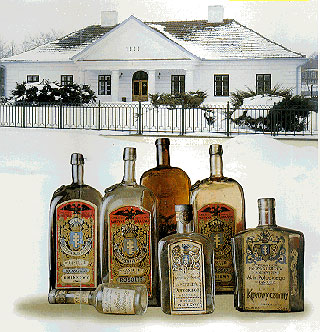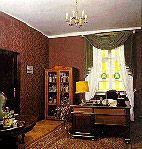|
|
![]() the
distillery history
the
distillery history
![]() the
museum
the
museum
 The
city of Lancut (pronounced wine-tzoot in Polish) is tied to the
history of the Lubomirski and Potocki families. Today Lancut is associated
above all with Lancut Castle, the Carriage House and precious collections
of paintings, sculpture and applied art. Less often recalled is its industry,
which nevertheless has played no small role in the city's and the castle's
history, bridging the old with the new, the past with the here and now.
The
city of Lancut (pronounced wine-tzoot in Polish) is tied to the
history of the Lubomirski and Potocki families. Today Lancut is associated
above all with Lancut Castle, the Carriage House and precious collections
of paintings, sculpture and applied art. Less often recalled is its industry,
which nevertheless has played no small role in the city's and the castle's
history, bridging the old with the new, the past with the here and now.
To
maintain this bond, to show what industry has meant to the growth of this
city, a company museum was organised at the Lancut Distillery portraying
the plant's traditions. It quickly became evident that this exhibition
concept did not convey the significance of the distillery industry to
the city and the Lancut estates, since its inception in 1784, so it was
decided to revamp the company museum and thereby create the Distillery
Museum, with a broader scope than the plant's "hall of tradition"
had. The museum is located in a neo-classic manor designed by Ludwik Boguchwalski.
Since 1970 the building has been maintained by the Lancut Distillery.
The manor was built in 1883. Once it was the headquarters of the estate
management. It is possible that the sugar-mill administration was housed
there for a time. From 1925 the building ceased to be the management headquarters
and became a residence.
After the Second World War the Farm Mechanisation Vocational Institute was installed there. The building was improperly used, and parts of it deteriorated. In 1993-1994, in concert with the Castle Museum in Lancut and the Museum of Factory Interiors in Lodz, it was decided to restore the manors appearance from its estate days, and to make the exhibition reflect the splendid epoch of Count Alfred Potocki's Privileged Distillery of Liqueurs, Rosoglios and Rum.
Adapting the dilapidated building for museum purposes demanded great effort. It was essential to renovate the manor's exterior, to search for exhibit items, and to research the original documentation.
 Inside
the museum, which is arranged in the style and spirit of the late nineteenth
Century we can trace the distillery's growth and become acquainted with
its everyday life. There are photographs, old documents, diplomas, labels
from the past, bottles with sometimes ornate shapes price lists, measurement
glassware, glasses used for tastings, and antique machinery -from Lancut
and from other parts of Poland.
Inside
the museum, which is arranged in the style and spirit of the late nineteenth
Century we can trace the distillery's growth and become acquainted with
its everyday life. There are photographs, old documents, diplomas, labels
from the past, bottles with sometimes ornate shapes price lists, measurement
glassware, glasses used for tastings, and antique machinery -from Lancut
and from other parts of Poland.
A model takes us through the whole gamut of work involved in distillation, from
start to finish. All the objects collected here, witnesses to days gone by, tell
the distillery's story best: its successes at grand international expositions,
its share in the life of this city.
 The
museum's windows are adorned with stained glass showing the coats of arms
of two families important to Lancut, the Lubomirskis and the Potockis.
In the office, furnished with late nineteenth-century furniture, there
is a guest book on the desk for museum visitors to sign, on the walls
of the fireplace room are portraits of the Potockis, copies of the ones
in Lancut Castle. Along the walls of other rooms are exhibits depicting
the history of the Polish distillery industry outside of Lancut. Closing
the circle we have travelled and capping the time we have spent, the exposition
features a collection of the beverages produced today.
The
museum's windows are adorned with stained glass showing the coats of arms
of two families important to Lancut, the Lubomirskis and the Potockis.
In the office, furnished with late nineteenth-century furniture, there
is a guest book on the desk for museum visitors to sign, on the walls
of the fireplace room are portraits of the Potockis, copies of the ones
in Lancut Castle. Along the walls of other rooms are exhibits depicting
the history of the Polish distillery industry outside of Lancut. Closing
the circle we have travelled and capping the time we have spent, the exposition
features a collection of the beverages produced today.
The Manor museum is surrounded by
a park. In front of the building are two white benches inviting you to rest.
Nearby one of the most modern distilleries in Poland bustles through its regular
shifts. And once again the past meets the here and now.
written by Joanna Bojarska